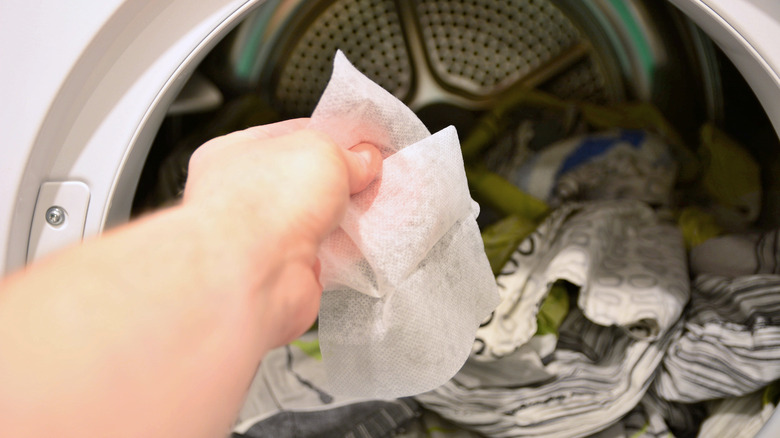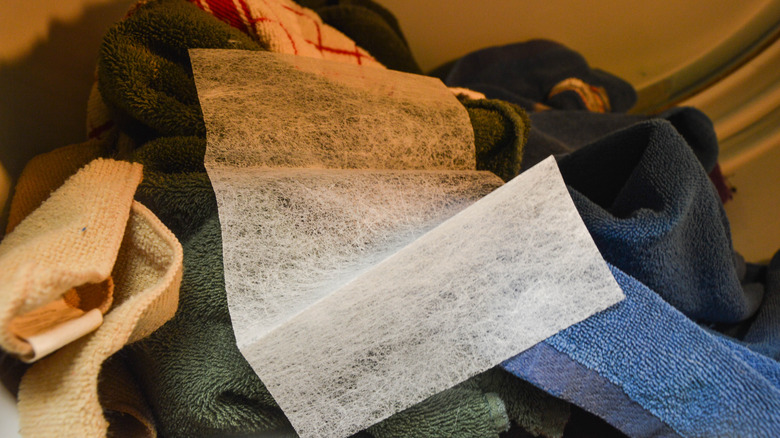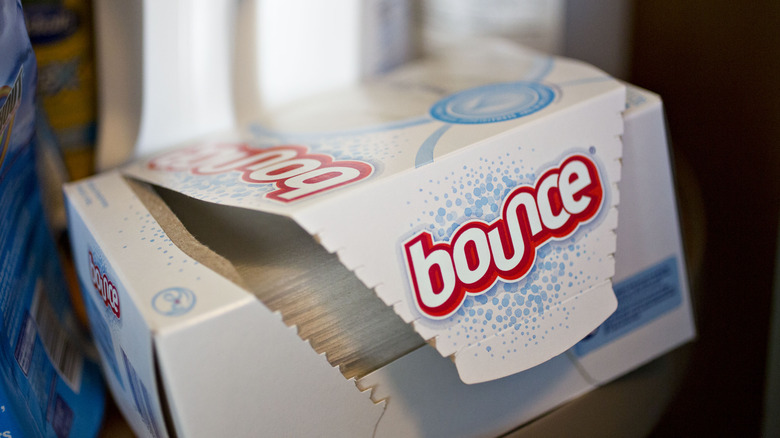Here's How Many Dryer Sheets You Should Be Using In Each Load
Your son's perpetually putrid-smelling gym socks may tempt you to toss an entire box of dryer sheets in a single load, but take a beat. Consistently acting on this impulse will bust your laundry budget in no time. Sure, dryer sheets are often viewed as a magic weapon when it comes to preventing smelly clothes, reducing wrinkles and static, and repelling pet hair; however, when it comes to deciding how many dryer sheets you should be using in each load, less is more — in most cases, one sheet will get the job done.
When dryer sheets were first invented in the late 1960s, one piece was all it took to freshen a single load of laundry. And we have a helpful husband to thank for the convenience. Conrad Gaiser, a chemist specializing in soaps and detergents, wanted to make life easier for his wife so he applied fabric softener directly to a scrap piece of cotton flannel. Since then, appliances and cleaning products have improved to no end, however, the humble dryer sheet is still a popular feature of many homeowners' laundry routine.
One and done
The invention of the dryer sheet gave birth to a load of other conveniences in the world of laundry, but it hasn't ended the controversy regarding how many sheets is too many? Most dryer sheet manufacturers suggest using one sheet for a small to medium load of laundry and two sheets for large loads. A simple rule of thumb is if you can fit your entire load of laundry in one arm, use one dryer sheet, however, if you need two arms to carry the load, add two dryer sheets. In instances where you are using extra-large commercial washers and dryers — like those found in laundromats and dorms — a third dryer sheet will serve as an added line of defense against static, lint, and odors.
Still, there is a difference between new and used dryer sheets. If you have a habit of leaving worn dryer sheets in the machine after unloading, don't count them as part of the grand total recommended by the manufacturer. Dryer sheets are nothing more than pieces of polyester treated with a blend of fabric softeners, fragrances, and lubricants. Consequently, a single cycle is all it takes to strip them of the active ingredients. To maximize dryer sheets' benefits, be sure to add fresh ones each time you run a load.
When to avoid dryer sheets
Conversely, you may be wondering if you need to be using dryer sheets at all. This is especially true for people who suffer from allergies or sensitive skin. If you are worried the chemicals in dryer sheets will trigger a rash, but you still want wrinkle-free clothes, consider using specialty dryer sheets. Several companies offer dryer sheets formulated to avoid irritating delicate skin. Most are dermatologist tested and leave out dyes and fragrances found in regular dryer sheets. The downside is hypoallergenic dryer sheets cost more than traditional brands. However, you only need to toss in one sheet per average-sized load in order to eliminate static cling.
There are times when you should totally steer clear of dryer sheets. For example, according to CNET, it is recommended not to add dryer sheets to a load if it includes children's pajamas. The chemicals used in standard dryer sheets compromise the integrity of the fire-resistant coating found on kids' sleepwear. Over time, they could completely strip the flame-retardant chemical from your child's jammies voiding it of its protective nature. In addition, stearic acid found in some dryer sheets can weaken the moisture-wicking effectiveness on sportswear and microfiber, and the same chemical can eat away at the products used to treat water-repellent fabrics, rendering them useless after repeated exposure. In these cases, it might be prudent to stop using dryer sheets and opt for alternatives such as wool dryer balls, tennis balls, or good old-fashioned line drying.


